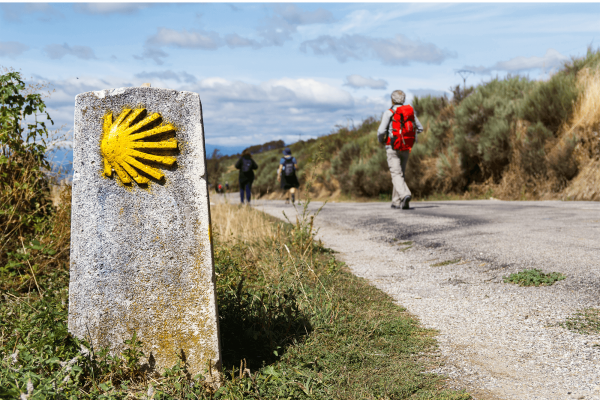FOR AGES, THOSE living as monks, cloistered nuns, hermits, and wandering pilgrims have mastered the art of turning loneliness into solitude, creating a real presence to themselves, and to God. These spiritual explorers were often confined—as many of us are now—into narrow spaces, yet pilgrimage to the authentic self explores an interior landscape. The exterior pilgrimage often reflects the interior path of spiritual imagination conducted in confinement. Their lessons and practices are not cloistered today; they offer liberating tools that can resurrect and protect the space for real presence for all who desire detachment from the omnipresence of screens. Simply consider this: You can’t walk on unexpected pathways while looking at screens.
Untethered from normalcy
Pilgrims move in two directions at the same time—an outward direction toward a holy destination and an inward journey seeking an encounter with the sacred. Two of the best academic scholars of pilgrimages, Victor and Edith Turner, explain it in this one sentence: “Pilgrimage may be thought of as extroverted mysticism, just as mysticism is introverted pilgrimage.”
Pilgrimages, they suggest, were, and are, no walk in the park, or plain, or mountain. Embarking on such a journey, we become untethered not just from our physical normalcy. These uncertain, trusting steps also move us out of our spiritual familiarity. The pilgrim is invited not only to walk out of boxes of dogmatic beliefs but also to walk away from practices of comfortable spirituality.
Consider historically the life of peasants or serfs in medieval Europe who were tied to a specific place—a manor, and a particular piece of land. Religious life was likewise confined to a local parish, with its repeated, routine practices. As pilgrimage opportunities began to be possible for a wide range of people, their journeys liberated them toward places unknown, with spiritual intensity. Pilgrimage sites were places where miracles had occurred. The bones of saints were living; the apparition of Mary created a rarified space. Healings occurred, continuing the miraculous nature of these sites.
As journeys to Jerusalem became insurmountable or impossible, numerous pilgrimage sites sprang forth throughout Europe. Yet those embarking on pilgrimages faced clear and present dangers. They were walking into liminal space, with a familiar past of place and spirit left behind and a future promise of spiritual power, wedded to tangible, material things, in the distance.
In their own context, this was a reckless spirituality, a form of extroverted mysticism. Of course, the underbelly of pilgrimage motives can’t be ignored—those seeking indulgences, or paid to travel on behalf of a wealthy, sedentary sinner, or those sentenced to a pilgrimage as recompense for a crime. But for most, this was a once-in-a-lifetime, embodied quest of spiritual abandonment. In the words of the Turners, “pilgrimage was the great liminal experience of the religious life.”
Rejecting modernity’s expectations
For today’s pilgrim it can be the same. A pilgrimage is a rejection of modernity’s expectations and assumptions about time, place, perception, satisfaction, speed, predictability, and the material world. As in ancient times, motives for contemporary pilgrimages are mixed. Lines between pilgrimage and tourism become blurred for some, while breaks in employment prompt others to a pilgrimage more than a thirst for embodied forms of holiness. Yet pathways that move simultaneously in inward and outward directions prove irresistible to throngs roaming pilgrimage paths today.
The most popular guide to the Camino de Santiago, one of the world’s best-known pilgrimage networks, is written by John Brierley. It’s the closest thing to a Bible that many pilgrims carry. Brierley breaks the Camino into segments that can be walked each day (though many dispute his assumptions about distance and endurance). The villages and sites are carefully recounted, with suggestions for pilgrim lodging and food.
Starting each of these 33 stages, he recounts “the practical path” and then “the mystical path.” For instance, going from Molinaseca to Villafranca del Bierzo in Spain, reflecting on the story of the Templar’s castle ruins in Ponferrada, he asks, “Are we ready for a leap of faith, ready to withdraw our investments in the limited consensual reality and bank instead on Reality unlimited?” Such interrogation of the soul, prompted by the places, shrines, and thousand-year-old stories of the Camino, confront the cloistered, secure patterns of spirituality that the pilgrim brings to the journey and can learn to leave behind. Again, to quote the Turners’ Image and Pilgrimage in Christian Culture:
A pilgrim is one who divests [oneself] of the mundane concomitants of religion—which become entangled with its practice in the local situation—to confront in a special, “far” milieu, the basic elements and structures of ... faith in their unshielded, virgin radiance.
In my experience, mysticism has always involved movement. That’s not like the unique whirling dervishes’ mystical prayers practiced for 700 years by the Sufi branch of Islam, although that is a fascinating study. Rather, simply walking, mindful of God’s presence, helps walk me away from inherited forms of spiritual practice.
My previous acts of faith devotion included almost solely reading a passage of scripture and silently praying, generally asking God to do certain things. What is changed by walking is focus. My focus is on presence—beginning regularly with the simple attempt to bring my inner self present to the reality of God’s love, which already and always is there, in each breath, and each step, upholding my life.
In one way or another, the Spirit yearns to break out and to break open our old practices, our protective shells of comfortable spirituality, connecting our inner selves more deeply to God’s love and to God’s world. Your soul no longer stays still. It’s moving with God in the world, and moving toward God, revealed in signs or shrines or saints or surroundings. The pilgrim’s walking body holds incarnate this inner journey of the soul, often recklessly.
Confronting an oppressive order
St. Nicholas Church in Leipzig, Germany, has an 800-year history, including when Johann Sebastian Bach served as choirmaster from 1723 to 1750. Listening to the Bach compositions played on the church organ there in the summer of 2017 brought his long legacy of music to life for me. But the service was being held to commemorate another period of St. Nicholas’ history—its crucial role in the fall of the East German Communist regime.
Monday evening prayer services started in the 1980s in this famous downtown Lutheran church. Though kept under surveillance by the omnipresent East German police, the Stasi, the church was one of the few places offering a protected haven for gathering, reflection, and discussion, as well as worship and prayer. The Monday evening prayer services opened a space for conversation about human rights, democratic aspirations, and a yearning for social and political change, along with studying the Sermon on the Mount and biblical themes of justice and social righteousness.
By 1989, these prayer meetings had begun to swell, filling the church, even as the disaffection of East Germans with their regime was yearning for expression. On Oct. 9 of that year, thousands gathered at the church, overflowing its pews and narrow balconies. Following the prayer service, they processed, armed only with candles. Thousands more joined them in the city center, moving in procession, confronting reinforced lines of riot police. But marching by candlelight requires one hand to hold the candle, and the other to protect it against wind and keep it burning. No one could carry anything threatening violence.
The gathering and procession of between 70,000 and 100,000 people was the largest one of its kind in East German history. The riot police had no response for prayerful, nonviolent marchers armed only with candles. They gave way, allowing the procession to go forward. More candlelight processions ensued throughout the country, and the courage of people’s public action increased. Just one month later, the Berlin Wall fell. Most agree that the prayer service and candlelight processions beginning at St. Nicholas Church were a pivotal step in events that led eventually to the fall of the East German regime.
A detached space had been provided by St. Nicholas Church for the inner spiritual preparation, clarity of vision, and commitment required for these East Germans willing to begin walking away, publicly, from their empire.
While pilgrimages can be described as going to a holy place, they are also steps made with a holy purpose. Seventy thousand or more marchers walking courageously around the Leipzig ring road were modern pilgrims whose steps became a public and political witness. Guided only by candles on an uncertain way forward, they were leaving behind a corrupt, oppressive political and economic order.
Acts of public witness
Walking on pilgrimages shaped by a holy purpose, and addressing stark injustices, ecological threats, racism, and violence all sustained by contemporary imperial power, has become in recent years a frequent avenue of witness and action. Beyond talking and writing, people want to walk in ways that embody their convictions and reveal the realities they wish to confront. The immigration crisis on the U.S. border with Mexico has witnessed numerous cross-border pilgrimages designed for this purpose.
One such dramatic pilgrimage in 2016, El Camino del Inmigrante, moved from the Tijuana/San Diego border 150 miles north to downtown Los Angeles, dramatically highlighting the need to address the injustices of the broken immigration system. Rev. Alexia Salvatierra, one of the key organizers, said, “In the Camino, we are seeing so many people who are being moved by the Spirit to join the cause of justice; I believe it is God’s moment for change to occur.”
The witness of pilgrimages can initiate changes in society. As the popularity of pilgrimages continues to grow in our time, the danger is that they will become a new way for people to seek privatized spiritual experience.
But pilgrimages are acts of public witness, where our feet do the talking. We are not walking for ourselves. Rather, like Celtic pilgrims without oars, our stepping into the boat is a surrender to the currents of God’s love. That love beckons us to leave the empire behind for the promise of a divine reign of justice, healing, and peace. Whatever our holy destination, our walking itself opens pathways toward a liberating future intended by the Creator.
This article is adapted from Without Oars: Casting Off Into a Life of Pilgrimage (Broadleaf Books, November 2020).

Got something to say about what you're reading? We value your feedback!






